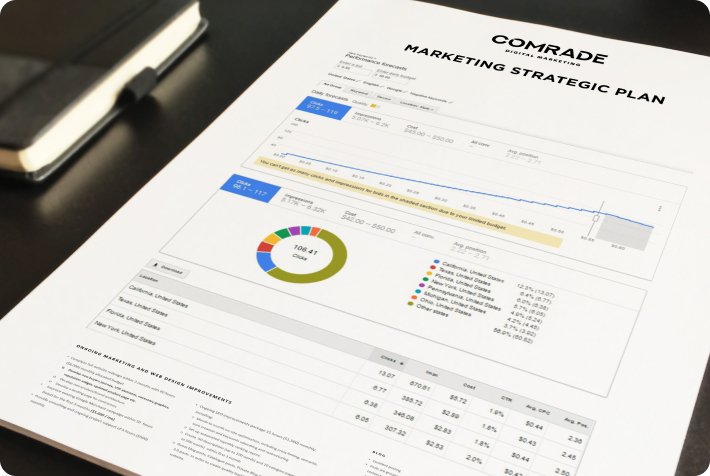With an estimated 24 million sites operating across the globe, eCommerce SEO is the only marketing strategy that guarantees a chance of repeatedly being discovered by your target audience.
What Is Ecommerce SEO?
eCommerce SEO is the process of optimizing an online store for search engines. One method for optimizing a product page is to write long descriptions using effective keywords. The SEO position of your online store can also be improved by getting backlinks from websites in a similar field. What’s more, you can use various eCommerce SEO tools such as the Page Speed tool to boost your site in the search results.
Is SEO Good for E-commerce?
SEO increases the number of visitors to your e-commerce website by helping it rank high on search engine result pages (SERPs). Your chances of obtaining the majority of those leads increase with ranking.
For example, Advanced Web Ranking reports have shown that websites that rank at the top of the SERPs have click-through rates (CTRs) of over 30%. However, the CTR drops more sharply as you move down the list of results. The further you are in the search results, the less likely you are to be found by someone.
Moreover, statistics show that 90% of people do not look for answers beyond the first page of the search. Thus, only being on the second page significantly reduces the chances of being found by potential customers.
How SEO for Ecommerce Works
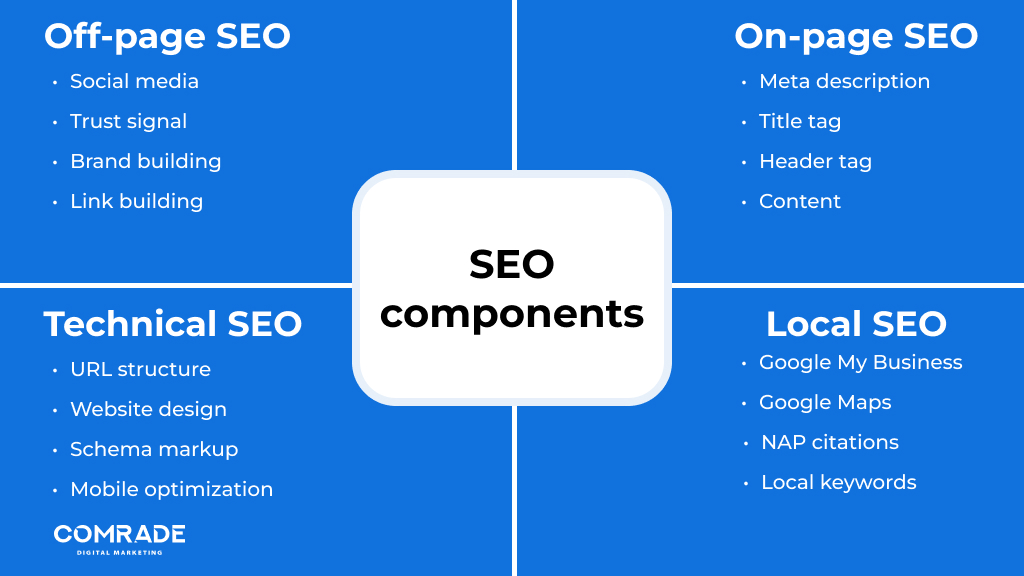
Several aspects of search engine optimization (SEO) contribute to ranking high on search results.
You have to ensure all aspects run optimally. It won’t pay off if you focus your marketing efforts on one component of SEO and neglect the others.
- On-Page SEO: This is the practice of optimizing content and HTML source code on web pages with relevant keywords to attract qualified traffic.
- Off-page SEO: Implementing tactics (off your website) that create exposure and trust for your company, such as eCommerce link building and guest blogging.
- Technical SEO: Website and server optimizations that make it easier for search engines to understand and rank your website.
- Local SEO: A technique that involves optimizing your Google My Business profile and Maps listings for better visibility within local search results.
Important: Know Your Target Audience!
25% to 40% of all prospective customers are found via organic search results. This is a significant portion of business derived from Google Search. Customers typically choose between the first three alternatives listed. Hence, the importance of being at the top of SERPs.
Much of ranking high on SERPs depends on on-page SEO for eCommerce, which is reliant on relevant keyword usage. Let’s assume you already know who your customers are and have segmented your target audience appropriately.
eCommerce SEO keywords (phrases) make it possible for your customers to find you online. So, you’ll have to perform keyword research to determine which keyword ideas work the best with your audience.
If your website is technically well-optimized for search engines and your keyword selection speaks the same language as your target audience, then you’ll rank above competitors, and Google will present your website site when your web content matches a lead’s query.
Search engine optimization is a methodical and meticulous process with many components. While it takes some time to implement and pay off, it offers the highest ROI in the long run.
Before we get into particulars, we should mention that by small businesses, we’re referring to eCommerce stores that generate 10 million dollars or less in sales.
Most small businesses fail at SEO for several reasons, yet it usually comes down to not having a good website and an underdeveloped eCommerce SEO campaign.
A good website means a robust structure, appealing design, fast loading speed, and a natural user flow, while a solid SEO for eCommerce means utilizing on-page, off-page, technical, and local SEO tactics.
Tackling eCommerce SEO head-on with the right marketing specialists makes all the difference in meeting your revenue goals, and staying ahead of the curve in an ever-growing market.
It’s essential to devote the time and resources to building your eCommerce business.
How to Get More Ecommerce Clients With SEO
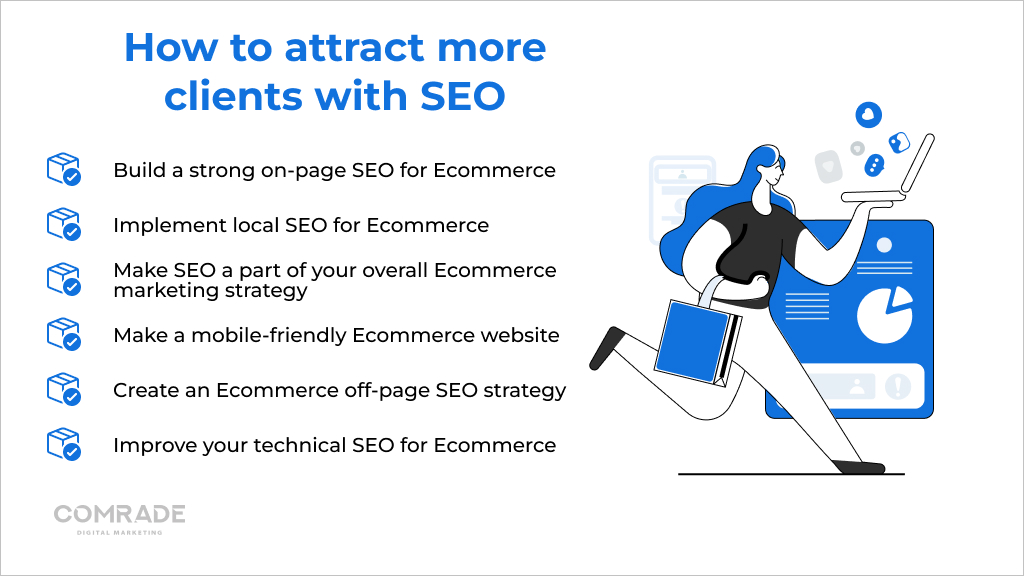
Professional boxers, dancers, swimmers, and athletes require focus to win their place at the top of the podium. From form to technique, there’s plenty to perfect. SEO for eCommerce best practices also consists of many elements that come together to execute a winning strategy.
Below are key considerations to ensure your eCommerce website appears in search results:
1. Build a Strong On-Page SEO for Ecommerce
On-page SEO strategies are a means of improving the HTML code (title tags, meta descriptions, headings) and the content of each web page to increase search engine ranking and drive more traffic to your eCommerce site.
By implementing a successful online SEO approach, you don’t only drive relevant traffic to your company and your brand, but you also aid search engines in analyzing your website and content better to ensure people seeking what’s on your website actually find it.
Content quality and eCommerce keyword research fulfill a significant role in building a strong on-page SEO campaign.
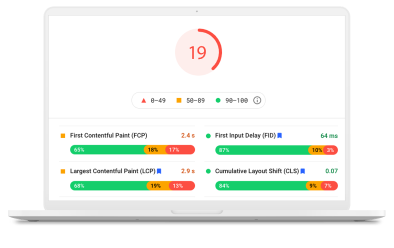
1.1 Conduct Ecommerce Keyword Research
When we speak of keywords, we’re referring to the words and phrases relevant to your target audience. Using the right combination of short and long-tail keywords can drive the right search engine traffic to your website—making them a powerful instrument to connect with your ideal customers.
There are four main types of keywords used to classify user intent:
- Navigational keywords—searchers intending to find a specific site or page;
- Informational keywords—searchers looking for an answer to a specific question;
- Transactional keywords—searchers intending to complete an action for purchase; and
- Commercial keywords—searchers looking for specific brands and services.
A keyword research tool like Google Keyword Planner or Ahrefs’ Keyword Difficulty Planner will provide some keyword ideas.
When it comes to selecting keywords, there are a few things to bear in mind. Not only do you need to use keywords that resonate with your audience, but you also need to select a combination that offers the best chance to rank on SERPs.
For instance, let’s say you’re a personal injury lawyer. Some keywords are more competitive than others. So, if you decide to use the keyword “personal injury lawyer,” it’s more than likely other firms’ websites are already ranking for the same keyword, which makes it exceedingly difficult to outrank them.
These keywords have a high keyword search volume. That’s not to say you shouldn’t use them, but rather to encourage you to use a combination of keywords. Long-tail keywords (generally made from three to five words) typically have a higher conversion value because they’re more specific.
An example of a long-tail keyword might be “how to choose a personal injury lawyer.” These types of keywords gradually garner more organic traffic to your website and help you rank higher.
You also have to factor in the sales funnel. Keywords used at the awareness stage will vary from those needed at the point of conversion.
1.2 Write for Humans, Not Just Search Engines
Concise and compelling copy will keep customers interested in your marketing content. Using the most effective keywords in your content and focussing on your customer’s needs will yield the most effective results.
One of the best ways to get people to read your content is through strong headlines (where you can insert keywords!) People are less likely to click on an article if the headline does not attract them.
Some wonderful title generator tools can help you. If you’re at a loss or writing simply isn’t your forte, then it may pay to hire professional copywriters. Any writer can attest that headlines are challenging. Just be sure to stay away from click-bait-sounding ones, as they’ll put off most readers.
Crafting content for people means making it easy to understand. Avoid too much industry jargon. Essentially, you want any literate person on the street to be able to read your writing and understand what you’re saying.
Lastly, don’t indulge in keyword stuffing. This is when you use a target keyword over and over again in your website’s content to manipulate search engine rankings. Both Google and people can detect this.
It’ll make your writing seem stilted and read like a marketing ploy, which is the opposite of what you’re trying to achieve.
1.3 Create Relevant Media
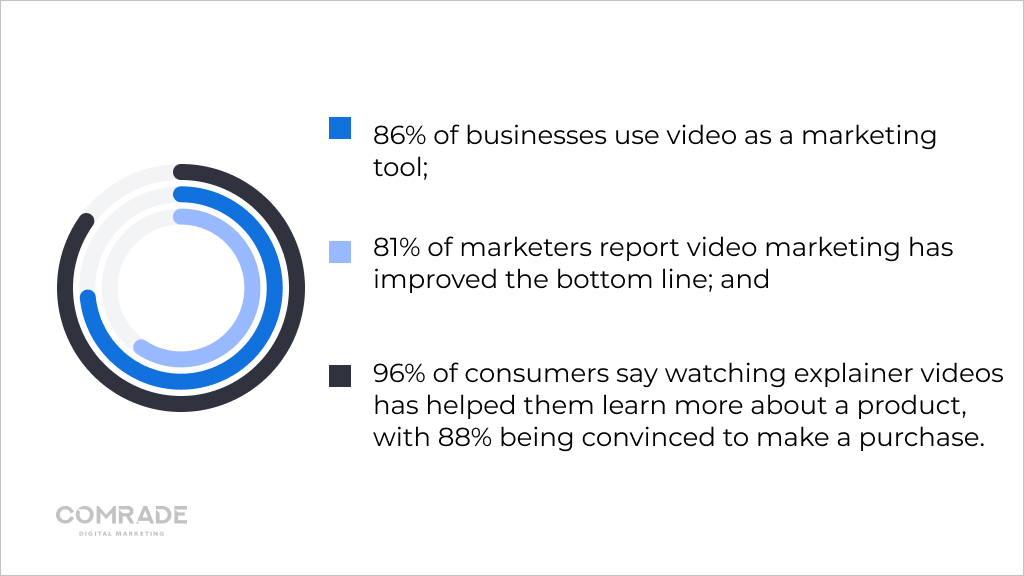
Consider using other media when people don’t want to read through a lengthy paragraph of text.
To draw from the latest content marketing statistics:
- 86% of businesses use video as a marketing tool;
- 81% of marketers report video marketing has improved the bottom line; and
- 96% of consumers say watching explainer videos has helped them learn more about a product, with 88% being convinced to make a purchase.
While blogging is still widely popular, TikTok, YouTube, and Instagram Reels and Stories also provide useful channels to engage with customers.
We recommend conducting market research to find out which social channels your audiences use and the type of content they prefer interacting with. There’s no fixed solution when it comes to content marketing mediums, as each business’ audience behaves differently online.
1.4 Link to Other Websites
External hyperlinks (outbound links) on eCommerce sites are believed to increase the power of your search engines, thereby boosting traffic and clients. They assist search engines in determining the usefulness and quality of your pages.
There are several reasons why outbound links are important:
They send positive signals to search engines and can boost a page’s rank in search results, improving visibility.
Since links point to related content, search engines can better establish knowledge hubs used to verify the importance of a given page or website.
Sites with zero links may appear unprofessional to users. So, strategic outbound links can help you build trust and credibility.
No website contains all the information on a given service or topic. When you link to other authoritative sites, you create more value for customers.
Having outbound links signals to others that you want to participate in the internet’s natural linking environment. It’s a great way to boost backlinks (off-page SEO).
Just remember to link to authoritative sites. You’ll have a higher chance of success if you link to, say, The New York Times or Wall Street Journal than some random blog post.
2. Implement Local SEO for Ecommerce
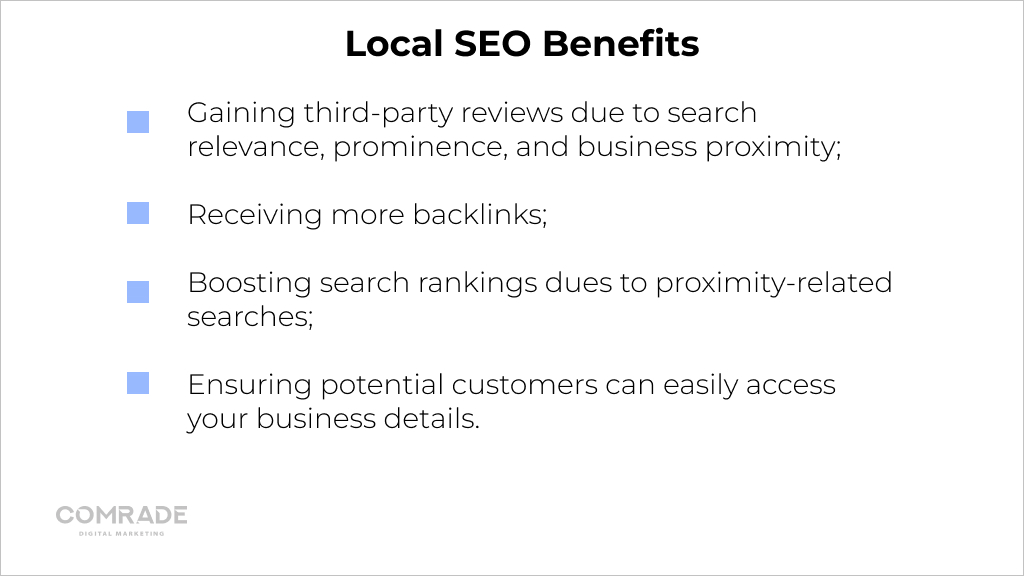
Local SEO helps your business be more visible in local search results. It ensures your business stays hyper-focused on its target audience rather than all around the country or the world (unless it’s a national or international business).
To start local SEO, you need to sign up for a free Google My Business account and optimize your NAP citations (Address, business name, phone number.)
So, why does local SEO matter if you ship all over the USA?
For starters, you can implement local SEO for multi-location businesses. But more importantly, almost 50% of all searches on Google have “local intent,” meaning users are seeking products and services nearby.
If they’re already searching for your type of product, you will surely want to pop up on Google search, even if your business operates nationally, right?
Local SEO for eCommerce has several other benefits too, like:
- Gaining third-party reviews due to search relevance, prominence, and business proximity;
- Receiving more backlinks;
- Boosting search rankings dues to proximity-related searches; and
- Ensuring potential customers can easily access your business details.
How to Get a Google My Business Account for Your Ecommerce Store?
Getting a Google My Business account is pretty simple. The challenge lies in being meticulous about accurately filling in information and completing all the steps.
To optimize your online presence for local eCommerce SEO, you need to:
- Create and verify a Google My Business Page;
- Encourage customers to leave reviews online;
- Respond authentically to reviews and mention the product and city-state in your response;
- Create a local content marketing strategy that appeals to your target audience living in different locations; and
- List your business in other local, online directories.
Read more about top tools for local SEO.
3. Make SEO a Part of Your Overall Ecommerce Marketing Strategy
An eCommerce SEO strategy yields the highest ROI. Despite that, many businesses turn to paid ads with no consideration of eCommerce keyword research, link building, or refining their product category pages or site architecture.
This is mainly because SEO is a comprehensive process that takes time. It’s much easier to whip up a paid advertising campaign than an SEO strategy. Paradoxically, SEO primarily requires upfront effort (with a little maintenance thereafter).
Once you rank, you’ll continue to do so. With advertisements, you stop receiving traffic the moment you cease pumping money into campaigns. Ideally, you should be doing both; just don’t ever replace a solid SEO strategy with paid advertising.
Besides monitoring your efforts with Google Search Console, here’s how to make sure your SEO strategy for ecommerce website is fully in line with your overall marketing strategy.
Looking out for mistakes is also a crucial part of any SEO campaign. Read more about eCommerce SEO mistakes here.
3.1 Provide Retargeting Campaigns to Customers
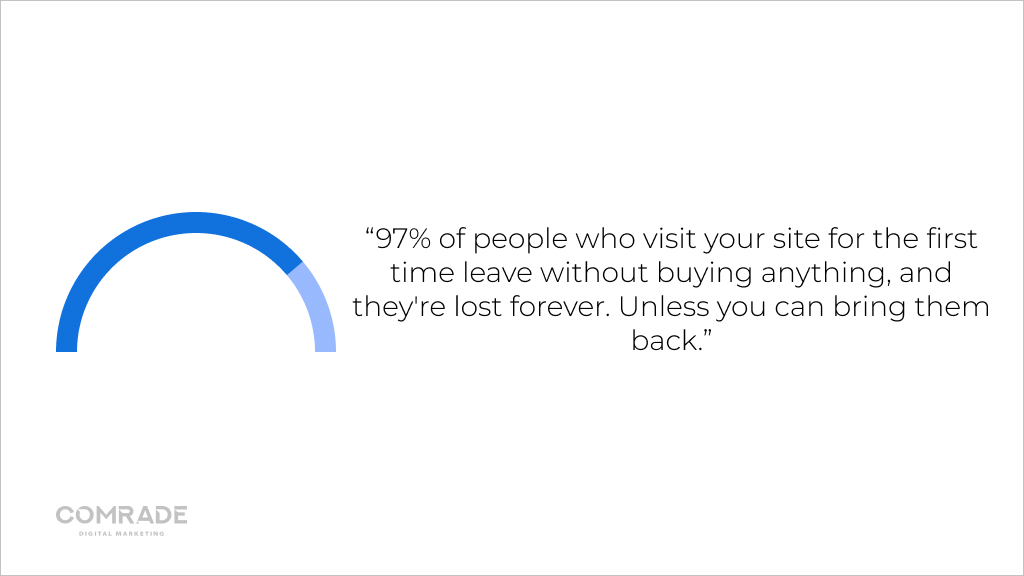
Retargeting is a strategy whereby you directly advertise to users who have shown an interest in your eCommerce product pages but have not converted.
For example, let’s say you’re an online home goods store and a customer adds a few items to their basket but never checkouts. You can email them a reminder of the items they neglected to purchase.
Case in point: Retargeting reduces cart abandonment by 6.5%.
As email automation software company MailChimp says: “97% of people who visit your site for the first time leave without buying anything, and they’re lost forever. Unless you can bring them back.”
Retargeting campaigns can be run with Google Ads, Facebook Ads, and LinkedIn Ads. It’s common practice for marketers to use retargeting tools to connect with potential customers while increasing sales and brand loyalty.
3.2 Promote Your Materials on Social Media
We’ve already said it before, and will repeat it again: make use of the power of your social media channels!
To increase the effectiveness of your SEO efforts, you should develop your own content strategy that will bring organic traffic from your social media channels to your website.
The key to success on social media is consistency. So ensure you create your strategy and keep regular schedules, so you can build a following and make an impact on the world.
Creating a content calendar for each platform helps keeps things on track. A good calendar lays out what kind of content you plan to post over a few months.
It’s also handy because despite living in an age of automation, sometimes online advertising messages have to change tact. For instance, when war broke out in Ukraine, some advertising would have been inappropriate.
Hence, having a calendar and being agile is key to getting social media advertising right. Regardless of your business size or type, try to keep your brand image, brand message, posting frequency, and hashtags consistent.
If your online store is just getting started on social media, then don’t stretch yourself too thin. Rather, produce quality content over quantity. You also don’t have to use every platform out there. Stick to one or two.
3.3 Combining YouTube and SEO
Our eCommerce SEO experts at Comrade did an in-depth study on SEO and YouTube. We found incorporating target keywords into video titles improves views and website traffic.
You can also search engine optimize YouTube video descriptions as well. While the official character limit for YouTube videos is 1,000 characters, it will only display about 100 characters. So, it’s best to front-load the description with the most important CTAs and links.
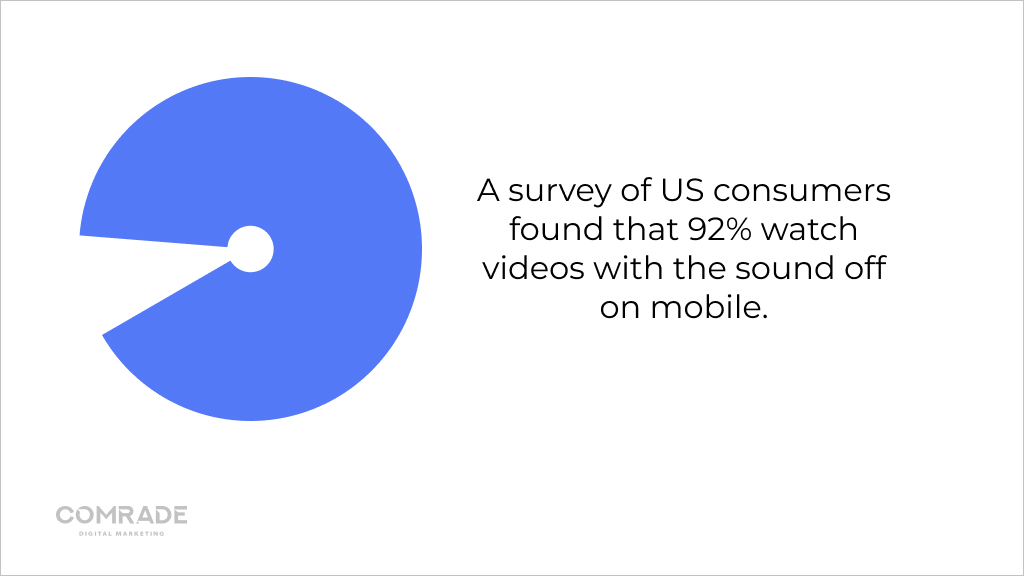
As for the video itself, consider adding a transcript. A survey of US consumers found that 92% watch videos with the sound off on mobile.
YouTube’s Creator Academy also suggests using keywords as video tags. So, you’re not just informing users what your video is about, but also YouTube. The video platform then figures out how to associate your videos with similar ones.
As a rule of thumb, lead with the most important target keyword first, including a mix of high search volume and long-tail keywords after that.
If you’ve got the hang of your SEO strategy, then integrating your keywords onto YouTube is a straightforward activity that will have a major impact on your website’s traffic.
3.4 Integrate User Reviews on Your Website
Reviews are excellent to establish trust in your brand and draw customers’ attention. They’re basically free advertising. Their original, authentic content is unique to your business and should be an essential component of your marketing strategy.
90% of customers read reviews before making a purchase. Potential customers seek social proof when they don’t know a brand, which reviews provide.
Reviews are also extremely valuable to eCommerce SEO because Google likes highly rated sites and ranks them higher.
Put it this way; if you were up against a website with equal optimization and your competitor had more positive reviews, Google would rank them above your site.
There are several ways to incorporate reviews on your website. You can either utilize Google reviews or record testimonial videos and post them on your eCommerce site and social media channels.
Having a review strategy in place also helps. Uber and Airbnb are excellent at this. Most customers don’t mind leaving reviews; they just hate going out of their way to do so. Some businesses integrate the process into their apps, send emails, or request reviews on social media.
4. Make a Mobile-Friendly Ecommerce Website
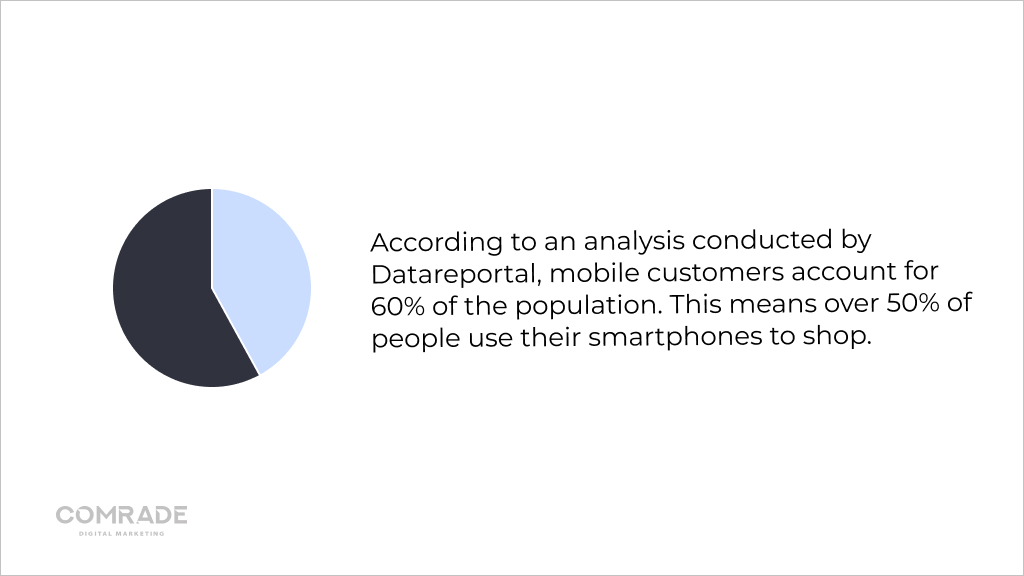
eCommerce websites have to accommodate smartphones and mobile devices. According to an analysis conducted by Datareportal, mobile customers account for 60% of the population. This means over 50% of people use their smartphones to shop.
The report highlights the mobile market segment dominates. In this regard, it’s crucial to concentrate on mobile-friendly SEO strategies for your eCommerce site.
Here are our recommendations for prioritizing SEO to meet the needs of mobile users.
4.1 Provide the Fastest Page Speed for Mobile
We touched on this point previously and can’t stress it enough. Your online store needs to load fast on mobile. And remember, what works on desktop won’t necessarily work for mobile devices.
Pop-up advertisements work great on desktop, but not so much on mobile. Lots of text can work on desktop, not so much on mobile. There is a distinction between the two. Even the way people use mobile vs. desktops or laptops.
If your site is slow on mobile, consider decreasing file sizes, and reducing the number of information servers needed to send each visitor. Fast pages make customers happy, and happy customers buy more.
4.2 Be Ready for Mobile-First Index
Google indexes websites according to their mobile versions. Yup, you heard right. The search engine concentrates its attention specifically on a website’s mobile version to determine its position in SERPs.
So, basically, you have to prioritize your website’s mobile functionality first. Nowadays, most website builders have templates that take this into account. Of course, any website designer worth their salt also knows this and develops websites that align with mobile requirements.
4.3 Improve Mobile UX
User experience (UX) is the interaction users have with an eCommerce site. UX design considers every element that shapes this experience, how it makes users feel, and how easy it is for them to accomplish what they came to do on your website or online store.
It’s everything from the color of your call-to-action buttons to the checkout process when buying products. Good UX design provides an all-around pleasant experience for users.
Here are our most popular suggestions to make your website’s UX shine:
- Use white (negative) space effectively. This increases readability;
- Segment key information with bullet points;
- Include well-designed and written headlines;
- Keep your website page design consistent; and
- Consider the customer’s journey.
A note on the customer’s journey: Potential customers expect a seamless experience from all digital interactions. They want to accomplish what they need to on whatever device they’re using.
For instance, lead capture forms will vary from desktop to mobile, as users are unlikely to fill out long forms on mobile. These differences in user behavior between devices must be accounted for.
5. Create an Ecommerce Off-Page SEO Strategy
We have discussed an on-page SEO strategy, but what is off-page SEO?
Instead of focusing exclusively on the content of your eCommerce site, off-page SEO concentrates on the actions you perform outside your website to boost your search rankings. These tactics improve the way search engines, such as Google, and other users, view your eCommerce website.
The primary off-page SEO strategy is link building. This is when other websites hyperlink to your website, increasing organic traffic, and revenue.
5.1 Choose Your Linkbuilding Strategy
When developing your link-building strategy, you should always focus on your target audience. Once you know they are, you’ll want to make a list of websites that can help you extend your audience reach.
Why? If your audience is already reading these websites, then links from them can help you reach people who might be interested in your site but perhaps don’t know about it yet.
You don’t want a link from every website there is. Only those respected by people and search engines. Websites with absolutely nothing to do with your niche or spammy sites can damage your marketing efforts.
Next, you want to create good content that your audience enjoys. Once you have developed a robust content track record, you can get in touch with the websites your visitors visit and ask them to link back to yours.
The way we’ve explained it is straightforward, but it may be a little more complex. For example, you may have to write a guest post or do a content exchange and mention their brand.
Finally, don’t forget to utilize social media. It is a fantastic way to drive more traffic directly to your website by sharing hyperlinks on your social media platforms.
5.2 Avoid the Black Hat Techniques
Black hat eCommerce SEO techniques are when marketers use unethical methods to rank higher on search results. Things like keyword stuffing, cloaking, and using private link networks are a big no-no.
“Bait and switch” content should also be avoided. This entails creating content around a topic you want to rank for, but then once you start ranking, you swap the content for something else.
Most of us have probably experienced clicking on a webpage only to have the information not satisfy our expectations. This creates a negative experience for searchers because the content they wanted to see no longer exists.
The black hat SEO techniques we’ve touched on will adversely affect your search rankings and visibility, resulting in a loss of traffic. Depending on how bad the offense is, Google can demote your page or remove it altogether.
While they may provide a needed quick fix, black hat SEO tactics have long-lasting negative consequences.
6. Improve Your Technical SEO for Ecommerce

Technical SEO for eCommerce is important because you can have the most amazing eCommerce online store; however, if it’s not technically optimized, your SEO rankings will suffer.
Crawlability is a search engine’s ability to access and crawl your website’s content. Broken links, for instance, can stop search engines from thoroughly accessing certain content on your eCommerce website.
Your search engine’s ability to analyze your website and add its pages to its index is called indexability. Poor site architecture, server errors, and broken page redirects can prevent web crawlers from doing their job, and stop your website from appearing on SERPs.
It’s SEO best practice to ensure your technical SEO is in order before you dive into other aspects like eCommerce keyword research, paid ads, meta tags, and so forth. Why?
Technical SEO is the base for your SEO performance. For this, you need to focus on things like site architecture, schema markup, site speed, and link structure to make sure your website is competitive.
6.1 Choose the Right Platform for Your Ecommerce Sites
There are several platforms on which to build your website, ranging from WordPress and Weebly to Squarespace and Shopify. Regardless of which you choose, it’s important to make sure it’s SEO-friendly.
Hiring a technical eCommerce SEO expert is recommended, as they will unlock the full potential of your online business. Furthermore, technical SEO requires knowledge of HTML and CSS, in other words, basic coding, which most people don’t have.
Nevertheless, alongside widely used web-building platforms is an alternative called Magento. Our team at Comrade has many years of experience providing Magento website development services. In 2021, we even had the honor of being recognized by Design Rush as one of the most popular Magento Developers.
Magento is as user-friendly as WordPress, which is great for those with little or no prior technical knowledge. The platform also has various new layouts and plugins, providing an easy shopping experience for customers.
As eCommerce SEO specialists, our essential strategies, like avoiding duplicate content and the secure use of HTTPS ensure the websites we design that are powered by Magento achieve our clients’ business goals.
When choosing a website builder, always ask the following:
- What are the hosting options?
- What are the customization possibilities?
- Is its SEO functionality more than adequate?
- Are its design templates mobile-friendly?
It comes down to specifics. Know what essential elements your website needs to succeed. A law firm website has entirely unique needs to an eCommerce store, for instance.
6.2 Develop Website Structure
How you organize your website’s content is essentially your website’s structure. A user-friendly structure helps visitors find information through connected pages.
There are four main types of website structures:
- Hierarchical Structure
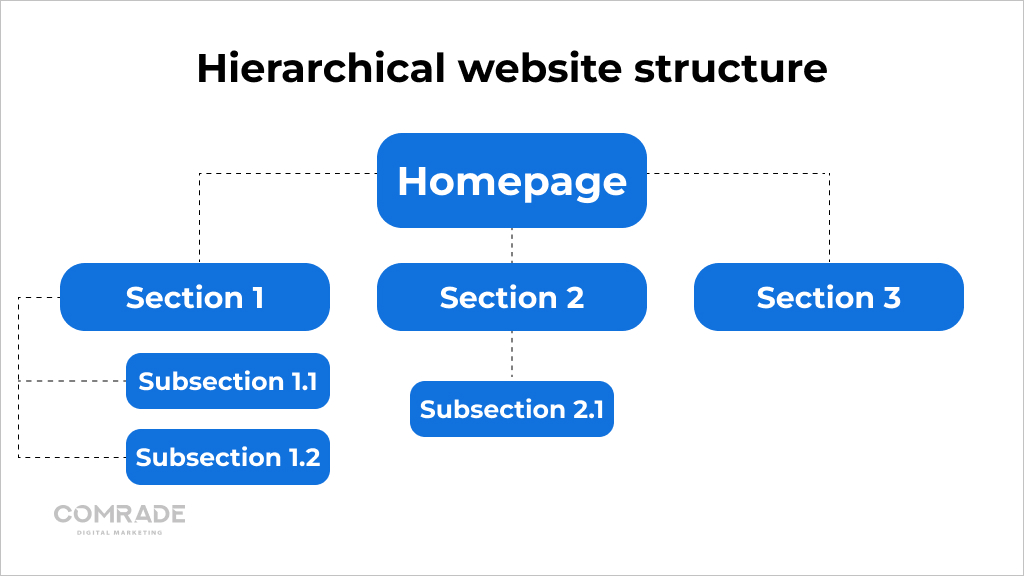
This is the most common type of structure implemented by the majority of businesses we design eCommerce sites for. It is mostly used for eCommerce sites that contain a huge amount of data. Hierarchical structures are similar to a tree in that they have a trunk (like a homepage) that branches out into product and category pages.
- Linear Structure
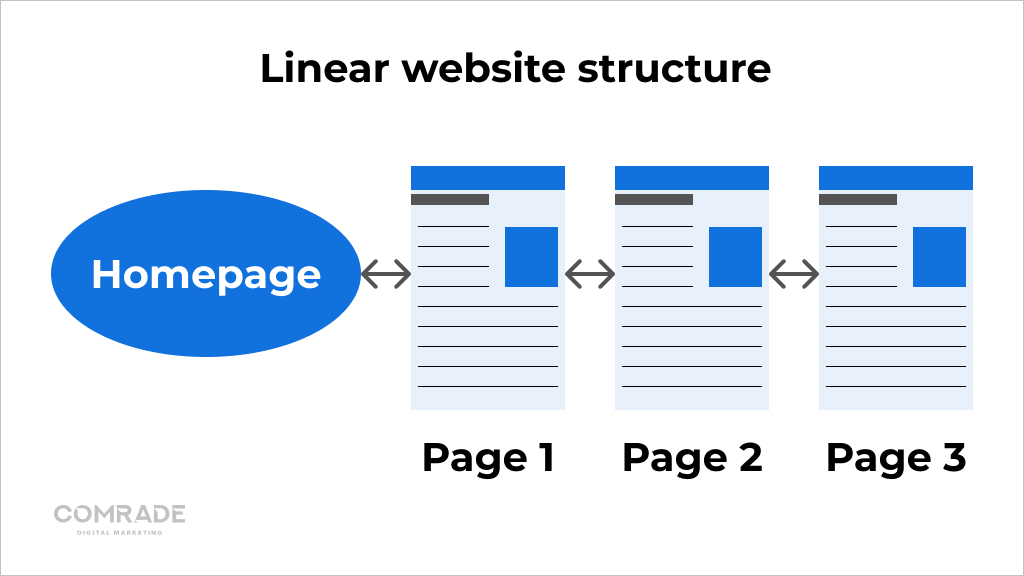
Linear websites have a beginning, middle, and end, similar to a printed book. This structure is less common and usually only used for exceptionally simple websites with a few pages. Manuals and microsites (if you’re launching a particular product or event) are suited to this structure.
- Network / Web-Linked Structure
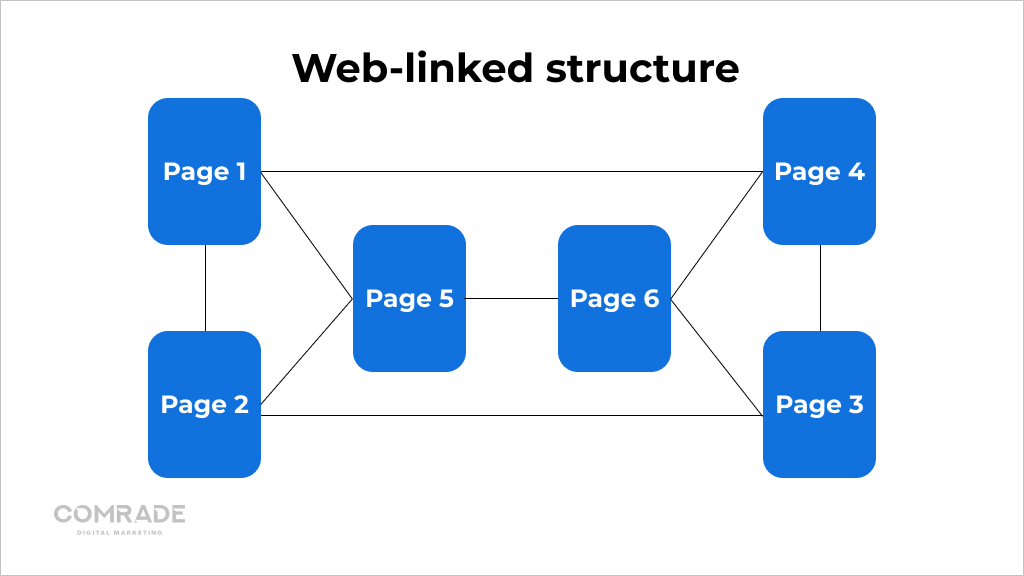
With a network structure, each page is linked to all other pages, so users can access any page while being on any other page on the website. Small websites work best with this site structure.
- Database Structure

A dynamic database site structure allows visitors to create their own experience based on the things they’re looking for. Good examples are Wikipedia and Google. Building this type of site requires stringent attention to metadata and content. It’s best suited to learning portals.
Your content needs and website intent determine the structure. Only once you know what your website should accomplish can you start thinking about site structure.
Regardless of your structure, it is essential to maximize SEO efforts by:
- Make sure your eCommerce site is scannable to speed up Googlebot indexing;
- Having a fast page load time (under two seconds if possible);
- Using relevant keywords when naming pages to rank higher on SERPs;
- Ensuring your main menu includes the most important product and category pages;
- Utilizing contextual links to external sources to establish credibility; and
- Updating your website navigation, including removing old and duplicate content and pages that viewers don’t need.
6.3 Internal Links
Internal linking is also an important part of site structure. An internal link is any link from one page on your website to another page on your website. Users and search engines need internal links to find content on your eCommerce site.
Internal links help Google build a site hierarchy, which bestows more value on certain webpages than others, and assists with accurate ranking.
An example of a good link structure: homepage > product page > category page
Crawl depth is something seldom mentioned but relevant to eCommerce sites. It refers to the extent to which search engines index eCommerce websites’ content. For example, an eCommerce store that requires three clicks to reach its product pages will be more difficult to index than an eCommerce website that takes just one click.
Search engines, in particular, use links to navigate your site. So, if you have an unlinked page, there’s a chance search engines won’t find it! Poor link structures also limit crawl depth and can make them miss important web pages.
There are also links within your content called contextual links. They point to relevant and related content. More than that, they allow search engines to determine the value of your content (not just what it’s about).
For instance, homepages tend to rank higher than category pages due to website hierarchy.
The more links a page receives, the more significant it appears to search engines. Obviously, internal links are advantageous for eCommerce SEO.
When people don’t find your content engaging, they’ll leave your site. However, if you can optimize the content with relevant internal links, you can decrease your bounce rate (people exiting).
The longer visitors linger, the more chances you have to convert them into customers!
6.4 Make Your Website Secure
The rise of third-party apps being privy to personal data has placed greater emphasis on consumer security. You’ll notice on search engines that websites either have HTTPS or HTTP in front of their domain names.
The main difference between HTTPS and HTTP is the former has an added layer of encryption (SSL/TLS) that makes it more secure. For instance, HTTP connections on public Wi-Fi networks are unsecured, meaning anyone can intercept communications.
However, you can transform an HTTP site to HTTPS by purchasing an SSL certificate (a digital security certificate). This is a small data file that protects the transfer of sensitive data between web browsers and web servers.
What’s more, HTTPS is a confirmed Google ranking factor. If there are two websites with equal weight, yet one has HTTPS, Google will rank the more secure website higher.
There are many Certificate Authorities (entities that issue SSL certificates). Only a few issue global ones, so do your homework beforehand. GoDaddy and GlobalSign are among the most trusted.
6.5 Create SEO-Friendly URLs
Do you realize your eCommerce site’s URL can be SEO-friendly? It’s true!
SEO-friendly URLs tend to be brief and emphasize keywords, thereby meeting the requirements of customers with easy, understandable, and accessible sequences.
When you are creating SEO-friendly URLs, we suggest using target keywords and avoiding using words like “the” and “and,” as they aren’t useful for SEO. Additionally, make sure your URL is sustainable, in the sense that you aren’t forced to change it as your business grows.
So, what exactly do we mean?
We’d consider this a poor URL:
A good URL might look like this:
In the second example, it’s apparent what the website and corresponding webpage are about. This makes it easy for search engines and users to understand what they’re looking at.
For this example, we can also assume “copyright infringement” is the page title and the main keyword.
6.6 Improve Page Speed
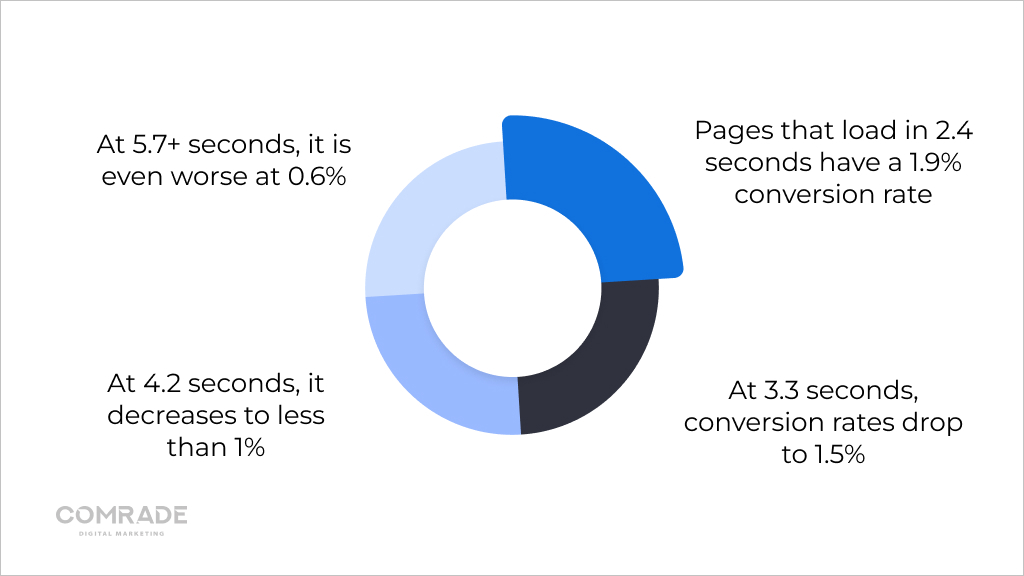
Our lives are quick-paced and thrive off instant gratification. As much as this shouldn’t affect digital marketing, it has a significant stronghold on the success of eCommerce SEO.
Current consumers detest slow-loading websites. Google has publicly stated the acceptable loading time threshold for eCommerce websites is under two seconds!
To give you a few examples:
- Pages that load in 2.4 seconds have a 1.9% conversion rate;
- At 3.3 seconds, conversion rates drop to 1.5%;
- At 4.2 seconds, it decreases to less than 1%; and
- At 5.7+ seconds, it is even worse at 0.6%.
Therefore, making sure that your page load speed is fast is essential to converting leads into customers. To improve loading speed, optimize images and videos, leverage caching, fix broken links and upgrade your web host package if need be.
What is caching? This is the process of storing copies of files in a cache, AKA a temporary storage location, so they can be accessed more quickly. Cache data is used to effectively load an app or website for every subsequent visit.

Conclusion
When you understand the basics of search engine optimization, your eCommerce website is bound to perform better in Google searches. From internal links to title tags and keyword research, there is so much you can do to improve your eCommerce SEO.
If your eCommerce store needs help with SEO, then our team of experts at Comrade Digital Marketing Agency will gladly partner with you in building a strong foundation for your eCommerce site and offer you a variety of eCommerce SEO packages to grow your business. Contact us for a complimentary SEO audit by a professional eCommerce SEO consultant.
Frequently Asked Questions
Where can I find your company?
Comrade originates in Chicago, but we worked all around the United States. We can help your business grow and increase revenue whenever you are. We have offices across most major cities in the US. For example, we can offer SEO services in Los Angeles or Boston. You can even find our SEO experts in San Jose! If you want to know more about our Pittsburgh SEO company or find out how exactly we can help you, contact us via the phone or email.


